|
No, not another JAT!
(Just Another Tomcat!) This kit has a symbolic significance for me. I first saw
it in the 1984 Tamiya Catalogue and thought it was the best kit in the world,
bar none. Unfortunately my dad baulked at the $125 price tag . Since then it's
always been "the one that got away" (my all-time favorite plane, the
perfect kit I couldn't afford, and the fact that the 'Cat went out of service
before I actually made the model) so 22 years later when I got my hands on the
kit at last, I decided to make it a tribute to the Tomcat's final swansong -
Operation Iraqi Freedom in 2003.
This aircraft was
the VF-31 "Tomcatters" CAG bird (Bu. no 164601, Modex 100) and
required upgrading the airframe and cockpit to F-14D standard, new weapons,
decal set and other modifications. I used the excellent Teknics F-14D Cockpit
Superset and Airframe conversions as well as adding Teknics' resin LANTIRN pod,
Cutting Edge AIM-9L/M Sidewinders, Flightpath's GBU-24 Paveway III and CAM's
GBU-31 USN JDAM. In addition I used Eduard's new etched set for the exterior and
Yellowhammer Decals' 1/48 "Iraqi Freedom Heroes" release which I
enlarged and reprinted in 1/32. So you are looking at about $200 worth of kit!
|
Click on
images below to see larger images
|
|

|
 |

|
This kit didn't
quite meet my high expectations - it's mostly manufactured with old tooling
(even the 1994 version of the kit) hence the need to re-etch all the raised
panel lines, the tedious filling and sanding of all the mysterious bulges and
dips all over the airframe, etching all the rivets and surface detail and
replacing the 1970s weapons fit provided. It fits together well (mostly - I got
through a lot of putty - Tamiya gray putty for filling in cracks, and Creos Mr
White Putty for smoothing off steps). For the paintwork I used Tamiya and Mr
Color lacquers for the three-color TPS scheme, and finished with Humbrol enamel
and Winsor and Newton oil washes. Pastel chalks provided a subtler finish around
panel lines and corners. I used thinned oil paint for the cockpit panels due to
its excellent opacity and better control. For exterior lights I used an
undercoat of Humbrol enamel silver, and then transparent lacquer which gave a
really good finish. I also used I used Pacer Zap-a-Gap CA glue for the
etch and resin detail work - it was perfect for its thicker viscosity and
10-second drying time, allowing for my mistakes!
I wanted this kit to look like a
warplane, dirty, grimy with patchy paintwork, and carrying a standard payload
rather than a "nice-looking" one - my references suggested Bombcats
flew with a GBU-12 or -24 LGB and a JDAM, (which they were converted in-theater
to carry) along with the LANTIRN targeting/GPS pod and usually a
Sidewinder/Sparrow (or occasionally Phoenix) combination of air-to-air missiles.
The aftermarket bombs were of a very high quality - the Paveway particularly was
made from resin and very high quality etched brass. The JDAM came pre-cast with
the USN fire retardant coating so looks particularly authentic. I also found out
that the attractive-looking metallic blue fuze on most Sidewinder pictures
actually means it is a practice or inert round, and live 'Winders actually have
a burnt metal color fuze. Likewise, the LANTIRN pods used by the Navy often had
parts colored in USAF Gunship Gray where they were common with the USAF version,
the remainder being Lt. Ghost Gray.
All areas of the
Tomcat look pretty beat up - each mission required 60 maintenance man-hours per
flight hour, so painting and decorating didn't really happen throughout the
entire deployment. I added paint chips and discoloration on the landing gear,
tailhook, and underbelly areas like on my photographs and references.
|
Click on
images below to see larger images
|
|

|

|

|
Tomcat production was killed off
as an economy move in 1991, just when the Navy wanted 127 new-build F-14Ds. The
result forced Grumman into a merger with Northrop and ended a fine tradition of
building world-beating carrier aircraft that had lasted 50 years. The D-model
Bombcat had an excellent war record in Afghanistan and Iraq, and until the
F-18E/F enters full service across the fleet, the Navy lacks a long-range,
all-weather bomber.
Proving it is all about
the weapons, sensors and network, and not about the platform, the venerable
F-14 Tomcat provided outstanding precision support (both JDAM and LGB)
and FAC(A). As we all know, 12 years ago the idea of a Tomcat dropping
ordnance was unheard of. However, with the addition of the Lantirn pod and,
recently, a Joint direct attack munition (JDAM) capability, the F-14 has
become a superb strike-fighter
(Rear Admiral Mark Fitzgerald, USN, Director Air Warfare. 2003)
As far as models go, you will see much better Tomcats and way better weathering
jobs elsewhere on this site, but I submit this example as a labour of love. It
may not look like 22 years and 200 bucks worth, and in better hands could have
been a real masterpiece. But since this great airplane is no longer in service,
I offer my approximation of this real-life warbird to the men and women who flew
it, worked on it and fought in it as a tribute to a fine legacy. Somehow I don't
think I'll be able to get as excited about the Super Hornet, JSF or F-22 in the
same way....!
Alan
|
Click on
images below to see larger images
|
|

|

|
|
|